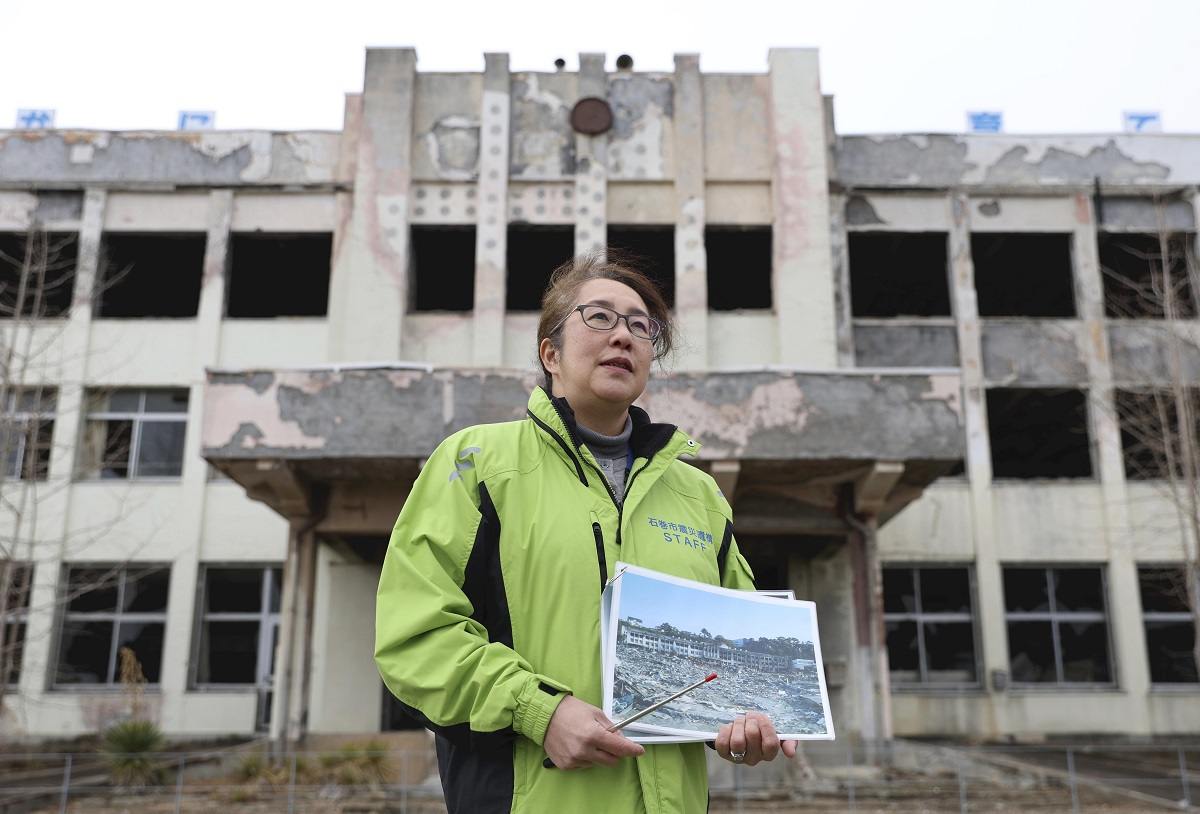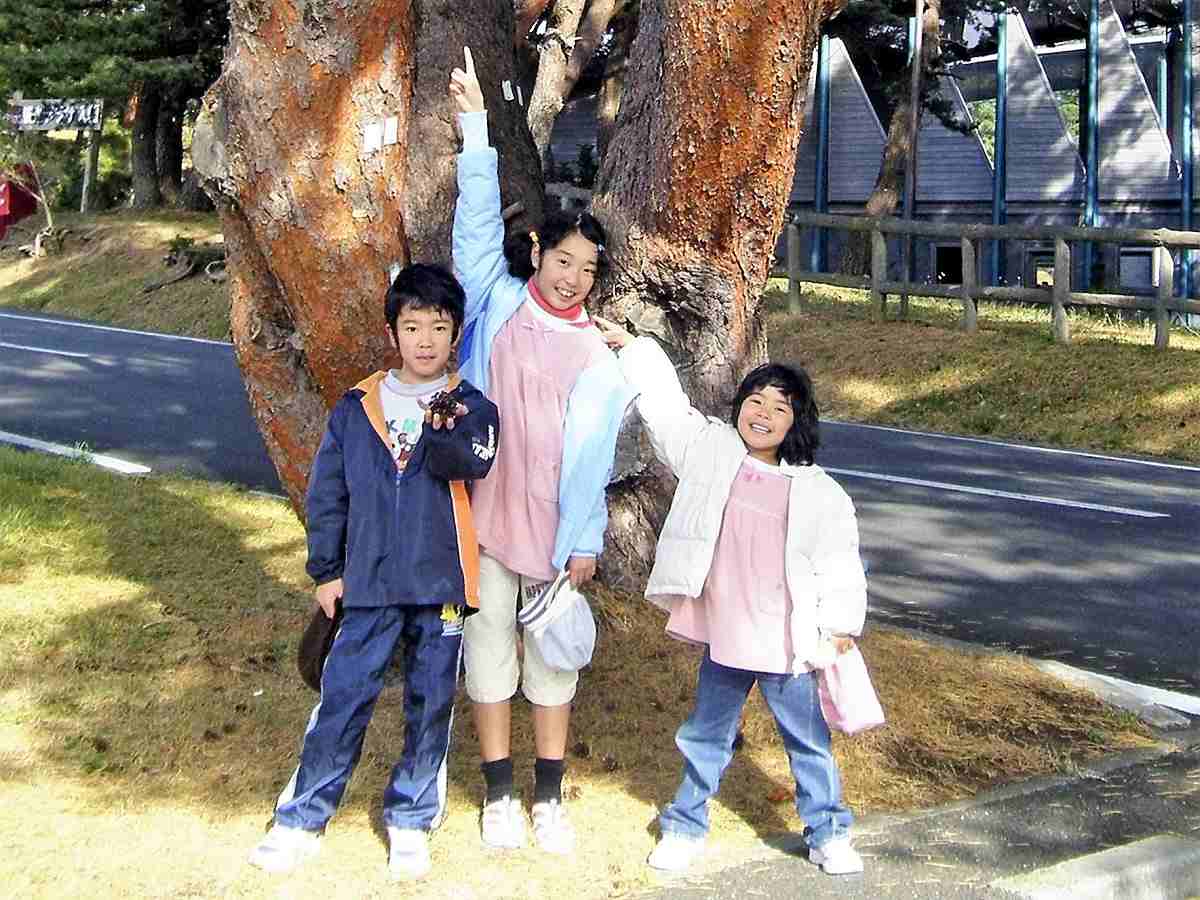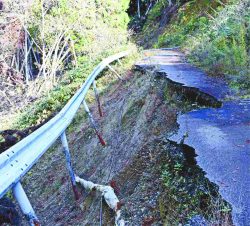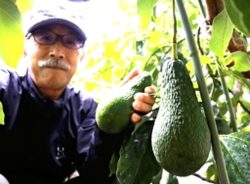Indescribable Pain of Losing All 3 Children; Mother Shares Tragic Story of 2011 Great East Japan Earthquake and Tsunami

Ryoko Endo works as a tour guide at Kadonowaki Elementary School Ruins in Ishinomaki, Miyagi Prefecture, on Feb. 27.
6:00 JST, March 11, 2024
There have been countless times when Ryoko Endo, 55, has wanted to live in a place where nobody knows her.
Even now, she feels her chest tighten whenever she tells her story. Despite that, Ryoko chose to become a tour guide at the disaster ruins in order to convey to others the lessons she learned, because she wants not a single other person to experience the pain she experienced.
Right after the earthquake occurred on March 11, 2011, Ryoko received an email on her mobile phone which read, “Your children are all safe. They’ve escaped to the gym.” At the time, she was working in a hospital about 6.5 kilometers away from her home in Ishinomaki, Miyagi Prefecture.
The email was from the elementary school where her eldest son Kanta, 10, and second daughter Kana, 8, attended. The email came when her eldest daughter Hana, a 13-year-old junior high school student, would have already gone home from school, as only morning classes had been scheduled that day.
Ryoko could not return home due to the damage caused by the tsunami. She spent two nights in a city government office building halfway from home.
In the morning on the third day, a TV program showed devastating footage of the situation in a town near her home which was hit by the tsunami.
She was determined: “I’m going to get home at any cost. I have to see my kids’ faces.” She continued the journey home on foot, walking on roads which were blocked by collapsed houses and debris. She was heading for the elementary school where her children should have taken shelter.
She arrived at the school building several hours later. A woman, one of her relatives, ran up to her and said, “You need to calm down and listen to me. Hana and Kana didn’t make it. Kanta is still missing.”
Ryoko could not immediately understand what the woman was saying.
When she was reunited with her husband Shinichi, 55, she let out her despair: “How could this happen?”
On the day of the disaster, Shinichi was worried about their children, so he took Kanta and Kana home from school, leaving them with Hana while he went out to check on his relatives.
While he was gone, their seaside house was struck by the tsunami, and the three children were swallowed by the waves. Kanta, who had been missing, was found dead near the home soon after.
The shock of losing all three of her children overwhelmed Ryoko. When she tried to eat cup noodles, she tasted nothing.
People would ask her, “What were your kids like?,” using the past tense, or call out to her saying, “Hey, mom!” which is a usual way to address women with children in Japan.
Each word was like a dagger. She eventually avoided meeting people.
“I was like a robot, no emotions or energy,” she said. There was only hopelessness.
One of Kyoko’s coworkers who was worried about her said, “You’ve got to go back to work. It’ll do you good.” Thus, Ryoko returned to work two months later.
She worked until exhaustion every day. Two years later, it became unbearable for her to spend her days escaping reality at work, so she quit her job.
Shinichi and Ryoko had to live their lives as the two remaining members of their family. Shinichi always drove when the couple went out. On such occasions, Ryoko thought, “It’s the least you can do for me, right?” Somewhere deep inside, she held a grudge against her husband.
At the same time, she understood that she could not go on living that way.
The first step for her was to begin training sessions for “paper drivers” — people who have their driver’s license but lack driving experience.
As she gradually improved her driving skills, her feelings started strangely to turn outward. She got interested in the exchange events which Shinichi had steadily continued to hold with people with whom they had shared a shelter.
People around the couple accepted the change naturally. One of them told Ryoko, “This is the first time I’ve seen you smile.” Another said, “I’m glad it seems you’re doing well.”
Ryoko started making leaflets for the exchange events instead of Shinichi, who is not very good at using a computer. She even became involved in managing the events.
“If I’d looked up from the darkness I was in, I would’ve seen a lot of people holding out a light for me. But I didn’t even try to look,” she said.
Now, the couple talk naturally about their three children: Hana, who wore her heart on her sleeve and had many friends; Kanta, who was gentle and loved living creatures; Kana, who had a strong sense of justice and disliked anything that wasn’t right.
Ryoko believes that the meaning of the couple’s life together can be found in those kinds of reflections.

From left, Kanta, Hana and Kana of the Endo family pose for a photo during a visit to Minami-Sanriku, Miyagi Prefeture, about two years before the Great East Japan Earthquake.
Not a day goes by when Ryoko does not remember her children.
There was an encounter that strongly reminded her that there are people who live in a different world. At one event, a young man asked her, “If you’re a resident of Ishinomaki, does that mean you witnessed the tsunami and things like that?” When she replied that she did not directly see the tsunami, the man said sharply, “What the hell?”
Around the same time, she happened to find a help-wanted ad at Kadonowaki Elementary School Ruins, which was damaged by a tsunami-triggered fire. In October 2022, she began working there.
Initially, she worked at the reception counter and other places, but she was invited to become a tour guide soon after.
She asked herself, “Would it be right for you to take to your grave the important things that you and survivors like you experienced without telling others only because it hurts to talk about them?” In October last year, she stood in front of visitors as a guide for the first time.
Visitors have included elementary school students taking extracurricular lessons, families on holidays and a group of disaster prevention experts.
In the guided tours, Ryoko shows such exhibitions as a classroom in which burned desks are lined up and tsunami-stained windows remain.
Ryoko usually does not talk about her own experience. But she is certain that the idea she wants to convey is reaching the visitors: “Just run for your life.”
Related Tags
"Society" POPULAR ARTICLE
-

M4.9 Earthquake Hits Tokyo, Neighboring Prefectures
-

Israeli Tourists Refused Accommodation at Hotel in Japan’s Nagano Pref., Prompting Protest by Israeli Embassy and Probe by Prefecture
-

M7.5 Earthquake Hits Northern Japan; Tsunami Waves Observed in Hokkaido, Aomori and Iwate Prefectures
-

Tsukiji Market Urges Tourists to Avoid Visiting in Year-End
-

M5.7 Earthquake Hits Japan’s Kumamoto Pref., Measuring Upper 5 Intensity, No Tsunami Expected
JN ACCESS RANKING
-

Tokyo Economic Security Forum to Hold Inaugural Meeting Amid Tense Global Environment
-

Keidanren Chairman Yoshinobu Tsutsui Visits Kashiwazaki-Kariwa Nuclear Power Plant; Inspects New Emergency Safety System
-

Imports of Rare Earths from China Facing Delays, May Be Caused by Deterioration of Japan-China Relations
-

University of Tokyo Professor Discusses Japanese Economic Security in Interview Ahead of Forum
-

Japan Pulls out of Vietnam Nuclear Project, Complicating Hanoi’s Power Plans























